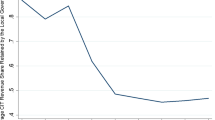Abstract
As part of the Trinity Reform, the Japanese Ministry of Internal Affairs and Communications (MIC) established the Administrative Reform Incentive Assessment (ARIA) program under the local allocation tax (LAT) system during the fiscal year 2005. This program was aimed at motivating local governments with LAT grants to raise their tax collection rates (TCRs) since a number of economists had asserted that LAT grants were eroding the fiscal discipline of local governments. Our paper uses empirical methods to estimate the average treatment effect (ATE) of the program and finds that it does not provide such an incentive and that the TCRs of local governments are unchanged by the Trinity Reform, irrespective of whether these governments receive LAT grants. We also conclude that the TCRs do not support the argument that LAT grants diminish the tax collection incentives of local governments.
Similar content being viewed by others
References
Akai, N., M. Sato and K. Yamashita (2003) The Economics of Local Allocation Tax Grants (in Japanese), Yuhikaku Inc., Tokyo.
Fukao, K. and X. Yue (1997) “Location decisions of Japan’s electric machinery firms (in Japanese),” Mita Gakkai Zasshi (Keio University) 90.2: 11–39.
Hayashi, M. (2006) “Economic Studies of Local Allocation Tax in Japan: A Critical Survey (in Japanese),” Journal of Economic Policy Studies 3.2: 6–24.
— and M. Ishida (2008) “Unsubsidized Public Work Projects and Covering the Redemption of Local Bonds in the Local Allocation Tax System: Estimation by Average Treatment Effect (in Japanese),” in Japan Institute of Public Finance (ed) Fiscal Restructuring and Tax Reform (Zaisei Kenkyu), Yuhikaku Inc., Tokyo, pp. 252–267.
Hayashi, T. (2009) “Review of the Collection Rate Index in Taxation and Empirical Analyses from the Root Causes of Collection Rate Differences among Local Governments (in Japanese),” Keizaigaku Ronkyu (Kwansei Gakuin University) 62.4: 97–124.
Hoon, C. (1996) “The Effects of Host Countries’ Tax Systems on Japanese and American Direct Investment Abroad: An Empirical Analysis of Investment by Manufacturing Industries in OECD Countries (in Japanese),” Hitotsubashi Ronsou (Hitotsubashi University) 116.6: 1158–1177.
Horiba, I., N. Mochida and K. Fukae (2003) “Local Allocation Tax and its Moral Hazard Effect on Property Tax (in Japanese),” Aoyama Keizai Ronsyu (Aoyama Gakuin University) 54.4: 27–58.
Geospatial Information Authority of Japan, Ministry of Land, Infrastructure, Transport, and Tourism (2006) A Land Survey of Prefectures and Municipalities.
Kaizuka, K., M. Homma, K. Takabayashi, J. Nagamine and K. Fukuma (1986) “The Function and Evaluation of Local Allocation Tax: Part I (in Japanese),” Financial Review 2: 6–28.
Kuroda, B. (2007) The Trinity Reform and Its Future Vision: Local Tax and Local Allocation Tax (in Japanese), Gyosei Inc., Tokyo.
Local Administration Bureau, Ministry of Internal Affairs and Communication (2006a) Actual Conditions of Local Public Employees in 2005.
— (2006b) A Population Summary from the Basic Resident Register in 2005.
Local Public Finance Bureau, Ministry of Internal Affairs and Communication (2007a) A Local Government Finance Survey (2005 Settlement).
— (2007b) A Survey of Municipal Accounts (2005 Settlement).
Local Tax Bureau, Ministry of Internal Affairs and Communication (2006) A Survey of Municipal Tax in 2005.
— (2010) Carried Forward Taxes and Tax Collection Rates of Local Taxes (2008 Settlement).
Ministry of Internal Affairs and Communications (MIC) (2010) White Paper on Local Public Finance, 2010—Illustrated—.
Nakai, H. (1988) A Quantitative Analysis of the Modern Fiscal Burden (in Japanese), Yuhikaku Inc., Tokyo.
Nishikawa, M. and A. Yokoyama (2004) “The Incentives of Local Governments for Tax Collection (in Japanese),” Japan Center for Economic Research Economic Journal 55: 165–179.
Statistics Bureau, Ministry of Internal Affairs and Communication (2007) The Population Census.
Tajika, E., E. Yui and M. Sato (2001) “What Are the Problems of Local Allocation Tax? Loosening Fiscal Discipline and Harming Fiscal Effort (in Japanese),” Zeikei Tsushin 56.12: 22–23.
— and T. Miyazaki (2008) “Local Allocation Tax and the Efforts of Local Government to Improve Financial Conditions (in Japanese),” Kaikei Kensa Kenkyu, 38: 25–37.
Wooldridge, J. M. (2010) Econometrics Analysis of Cross Section and Panel Data, 2nd ed., The MIT Press, London.
Author information
Authors and Affiliations
Corresponding author
About this article
Cite this article
Ishida, M. Intergovernmental Grant and Tax Collecting Efforts in Japan: Estimating the Effect of Local Allocation Tax Grants on Local Tax Collection Rates. Evolut Inst Econ Rev 9 (Suppl 1), S55–S73 (2012). https://doi.org/10.14441/eier.9.S55
Published:
Issue Date:
DOI: https://doi.org/10.14441/eier.9.S55
Keywords
- local allocation tax
- tax collection rate
- Administrative Reform Incentive Assessment
- average treatment effect




